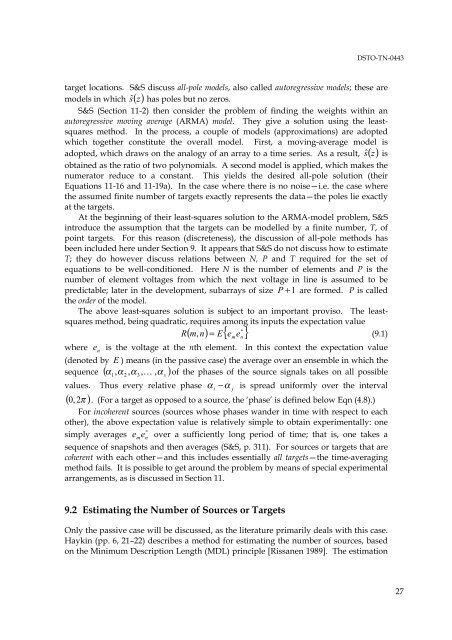Suitability of Correlation Arrays and Superresolution for Minehunting ...
Suitability of Correlation Arrays and Superresolution for Minehunting ...
Suitability of Correlation Arrays and Superresolution for Minehunting ...
You also want an ePaper? Increase the reach of your titles
YUMPU automatically turns print PDFs into web optimized ePapers that Google loves.
DSTO-TN-0443<br />
target locations. S&S discuss all-pole models, also called autoregressive models; these are<br />
models in which ŝ () z has poles but no zeros.<br />
S&S (Section 11-2) then consider the problem <strong>of</strong> finding the weights within an<br />
autoregressive moving average (ARMA) model. They give a solution using the leastsquares<br />
method. In the process, a couple <strong>of</strong> models (approximations) are adopted<br />
which together constitute the overall model. First, a moving-average model is<br />
adopted, which draws on the analogy <strong>of</strong> an array to a time series. As a result, ŝ () z is<br />
obtained as the ratio <strong>of</strong> two polynomials. A second model is applied, which makes the<br />
numerator reduce to a constant. This yields the desired all-pole solution (their<br />
Equations 11-16 <strong>and</strong> 11-19a). In the case where there is no noise—i.e. the case where<br />
the assumed finite number <strong>of</strong> targets exactly represents the data—the poles lie exactly<br />
at the targets.<br />
At the beginning <strong>of</strong> their least-squares solution to the ARMA-model problem, S&S<br />
introduce the assumption that the targets can be modelled by a finite number, T, <strong>of</strong><br />
point targets. For this reason (discreteness), the discussion <strong>of</strong> all-pole methods has<br />
been included here under Section 9. It appears that S&S do not discuss how to estimate<br />
T; they do however discuss relations between N, P <strong>and</strong> T required <strong>for</strong> the set <strong>of</strong><br />
equations to be well-conditioned. Here N is the number <strong>of</strong> elements <strong>and</strong> P is the<br />
number <strong>of</strong> element voltages from which the next voltage in line is assumed to be<br />
predictable; later in the development, subarrays <strong>of</strong> size P + 1 are <strong>for</strong>med. P is called<br />
the order <strong>of</strong> the model.<br />
The above least-squares solution is subject to an important proviso. The leastsquares<br />
method, being quadratic, requires among its inputs the expectation value<br />
R ( m,<br />
n ) = E { e e ∗<br />
m n}<br />
(9.1)<br />
where e<br />
n<br />
is the voltage at the nth element. In this context the expectation value<br />
(denoted by E ) means (in the passive case) the average over an ensemble in which the<br />
sequence ( α<br />
1, α<br />
2<br />
, α<br />
3,<br />
K , α s<br />
) <strong>of</strong> the phases <strong>of</strong> the source signals takes on all possible<br />
values. Thus every relative phase α − α is spread uni<strong>for</strong>mly over the interval<br />
( , 2π )<br />
i<br />
0 . (For a target as opposed to a source, the ‘phase’ is defined below Eqn (4.8).)<br />
For incoherent sources (sources whose phases w<strong>and</strong>er in time with respect to each<br />
other), the above expectation value is relatively simple to obtain experimentally: one<br />
∗<br />
simply averages e me n<br />
over a sufficiently long period <strong>of</strong> time; that is, one takes a<br />
sequence <strong>of</strong> snapshots <strong>and</strong> then averages (S&S, p. 311). For sources or targets that are<br />
coherent with each other—<strong>and</strong> this includes essentially all targets—the time-averaging<br />
method fails. It is possible to get around the problem by means <strong>of</strong> special experimental<br />
arrangements, as is discussed in Section 11.<br />
j<br />
9.2 Estimating the Number <strong>of</strong> Sources or Targets<br />
Only the passive case will be discussed, as the literature primarily deals with this case.<br />
Haykin (pp. 6, 21–22) describes a method <strong>for</strong> estimating the number <strong>of</strong> sources, based<br />
on the Minimum Description Length (MDL) principle [Rissanen 1989]. The estimation<br />
27

















